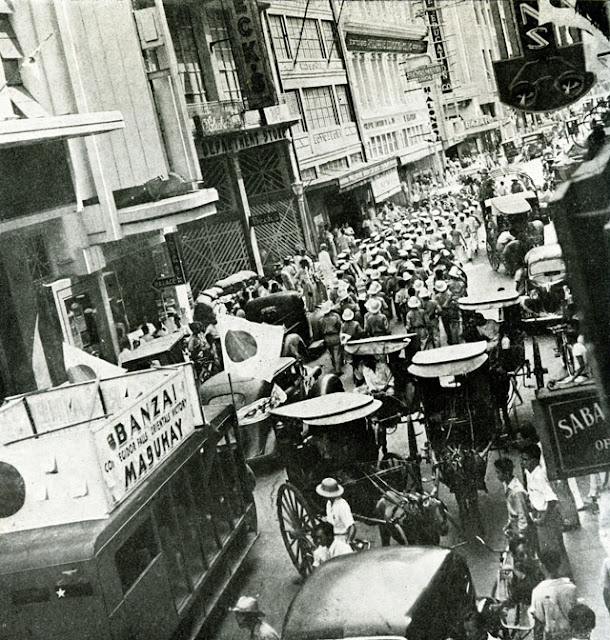Saturday 9 May 1942
 |
| "German U-boat, U-352, May 1942. 33 German prisoners were brought ashore at the Navy Yard, Charleston, South Carolina, by US Coast Guard cutter Icarus (WPC-110) after the sinking of the German submarine, U-352, off the Atlantic coast on 9 May 1942. The Executive Officer of the German submarine repeats in German the instructions given to him by US Navy officers as the crew eat “chow.”" Naval History and Heritage Command 80-G-41304. |
Battle of the Pacific: Rear Admiral Frank Jack Fletcher takes Task Force 17 out of the Coral Sea on 9 May 1942, ending the Battle of the Coral Sea. With only one fleet carrier, USS Yorktown left, Fletcher proceeds south of New New Caledonia and proceeds toward Tongatabu to refuel. Australian Rear Admiral John Crace, in charge of Task Force 44, keeps his cruiser force in the area throughout the day to guard Port Moresby.
The Japanese fleet is short of fuel, so Vice Admiral Takeo Takagi's Carrier Strike Force, also down to one carrier (Zuikaku), spends the day refueling. Admiral Isoroku Yamamoto has ordered him to pursue and engage the Allied warships again. In the evening, Takagi heads southeast with his refueled ships, then turns southwest toward the Coral Sea. The invasion of Port Moresby remains on hold unless and until Takagi can eliminate the Allied forces.
The Japanese recently set up a seaplane base in the Deboyne Islands during the opening stages of Operation Mo in order to assist with the invasion of Port Moresby. Today, the Allies begin a series of air raids on the base that damage seaplane tender Kamikawa Maru and eventually force the Japanese to leave.
Having taken the US island fortress of Corregidor, the Japanese seek complete control of the Philippines by taking Dalirig on Mindanao.
 |
| Manila, the Philippines during the Japanese occupation, 9 May 1942. |
Battle of the Indian Ocean: The Burma Corps continues withdrawing west across the Chindwin River. Today, the divisional headquarters and the 13th Indian Infantry Brigade makes the crossing. Their destination is the border town of Tamu, which is not that far but will require traversing some rough, roadless terrain
 |
| USS Albacore in Measure 9 camouflage (dull black) off Groton, 9 May 1942. |
Eastern Front: It is day two of the German offensive in Crimea and everything is going the Wehrmacht's way. General Franz Halder's war diary entry is short and succinct: "Breakthrough on the southern wing. The attack is making good progress. All quiet on the rest of the front."
General Erich von Manstein's attempt to clear the Kerch peninsula, Operation Trappenjagd ("Bustard Hunt"), continues on 9 May with great success. In some ways, the operation resembles the opening days of Operation Barbarossa in June 1941, with crushing German domination sweeping aside all opposition. Where the Germans attack, the Red Army gives way, and casualties are light.
German engineers have successfully created an opening through the Soviet anti-tank ditch in the south. Manstein uses it to commit the 22nd Panzer Division in a move east, then north to the Sea of Azov coast. This maneuver eventually traps the Soviet 51st Army in a pocket, isolating about one-third of the Soviet strength. The 44th Army in the south is in disarray, and the 47th Army in reserve at Kerch is slow to react, hampered by Luftwaffe attacks on the roads.
 |
| Colonel-General Erich von Manstein, left, and Luftwaffe commander Wolfram von Richthofen in Crimea, May 1942 (Cherry, Federal Archive Image 183-B18908). |
The Red Army counterattacks with its armor, but the Luftwaffe has complete aerial superiority and, with little tree cover, an open field of fire on the roads. Luftwaffe General Wolfram von Richthofen has assembled overwhelming power from units that have returned from the Reich after being refurbished over the winter. German planes down 25 Soviet planes over the breakthrough point and wreak havoc on the counterattacking Red Army tanks. The Luftwaffe launches 1700 sorties during the day, not far under the 2100 sorties on the first day of the offensive. Overall, the Luftwaffe claims 52 Soviet planes shot down during the day for only two losses. A rainstorm during the evening effectively ends operations for the day.
General Hans Zorn, the commander of the breakout attempt from the Demyansk pocket that ultimately led to its relief (in conjunction with Seydlitz's advance to Ramushevo), visits Fuhrer Headquarters in East Prussia. Halder writes that he looks "Quite worn!"
European Air Operations: After 12 Boston bombers attack Bruges oil storage tanks and Hazebrouck railway yards, it is a quiet night. The only activity by either side is a mission by 20 RAF bombers to lay mines off Denmark and Germany. There are no losses.
 |
| German U-boat, U-352, May 1942. 33 German prisoners were brought ashore at the Navy Yard, Charleston, South Carolina, by US Coast Guard cutter Icarus (WPC-110) after the sinking of the German submarine, U-352, off the Atlantic coast on 9 May 1942. US Marines, with fixed bayonets, stand guard as prisoners are lined up in front of the Coast Guard cutter (Naval History and Heritage Command 80-G-41302). |
Battle of the Atlantic: U-352 (Kptlt. Hellmut Rathke), on its send patrol out of St. Nazaire, is depth-charged and sunk near Morehead City, North Carolina by US Coast Guard ship Icarus. There are 15 deaths and 33 survivors. The submarine ends its career with no victories.
U-162 (FrgKpt. Jürgen Wattenberg), on its second patrol out of Lorient, torpedoes and sinks 1905-ton Canadian freighter Mount Louis south of Trinidad. There are 13 deaths and 8 survivors, who are rescued by Canadian freighter Mona Marie.
U-564 (Kptlt. Reinhard Suhren), on its fifth patrol out of Brest, torpedoes and sinks 7138-ton Panamanian tanker Lubrafol three nautical miles off Delray Beach, Florida. There are 13 deaths and 31 survivors, who are rescued by US Coast Guard ships. Lubrafol does not actually sink today, but it is a burning wreck with no hope of salvage until it finally does go under on 11 May.
 |
| Near Bir Hacheim in North Africa, a German soldier wearing a pith helmet mans a 7.92mm machine gun MG15 with tripod on a motor vehicle, May 1942 (Zwilling, Ernst A., Federal Archive Image 101I-443-1551-06A) |
U-69 (Oblt. Ulrich Gräf), on its eighth patrol out of St. Nazaire, torpedoes and sinks 6825-ton Norwegian tanker Lise northeast of Aruba. There are 12 deaths and 33 survivors, many of whom are rescued by two Dutch ships while others make it to shore in lifeboats. Some sources place this sinking on 12 May.
U-125 (Kptlt. Ulrich Folkers), on its fourth patrol out of Lorient, torpedoes and sinks 11,941-ton Canadian tanker Calgarolite 50 nautical miles (93 km) southwest of Grand Cayman Island. Folkers surfaces when the tanker does not sink right away and uses his deck gun to finish the job. All 45 crewmen survive.
The Luftwaffe bombs and sinks 928-ton Norwegian freighter Douro midway between Iceland and Scotland. There are ten deaths and ten survivors, who are rescued by Icelandic trawler Gyllir.
German 125-ton minesweeper R-45 collides with a minesweeper tender off Dunkirk, France, and sinks. Also sunk in the collision is 508-ton M-533.
 |
| British Spitfire V fighter taking off from carrier USS Wasp for Malta, 9 May 1942 (US National Archives). |
Battle of the Mediterranean: The US Navy and Royal Navy mount another carrier ferry mission to Malta today. This is Operation Bowery. USS Wasp and HMS Eagle launch 64 Supermarine Spitfires, with 58 actually making it to the island. Despite the losses, this is much more successful than Operation Calendar, when a similar ferrying mission resulted in disaster when the fighters were quickly attacked and mostly destroyed by the Luftwaffe. Operation Bowery is a successful mission that builds on the learning experience of Operation Calendar.
This mission leads Prime Minister Winston Churchill to comment, "Who said a Wasp couldn't sting twice?" The presence of the Spitfires essentially ends the daylight bombing campaign against Malta.
 |
| An internee awaiting the evacuation bus, 9 May 1942. |
American Homefront: "Tangerine" by Jimmy Dorsey and His Orchestra with Bob Eberly and Helen O'Connell becomes the No. 1 song on the Billboard chart. It knocks off "Moonlight Cocktail" by Glenn Miller and His Orchestra with Ray Eberle and the Modernaires after ten weeks. Ray Eberle and Bob Eberly are brothers despite the slight differences in their last names, Bob just changed his for professional purposes.
Thoroughbred Alsab wins the Preakness, spoiling the chance of Shut Out to win the Triple Crown.
Future History: John David Ashcroft is born in Chicago, Illinois. He becomes a politician from Missouri who becomes Governor of that state, a US Senator, and the US Attorney General from 2001-2005.

No comments:
Post a Comment